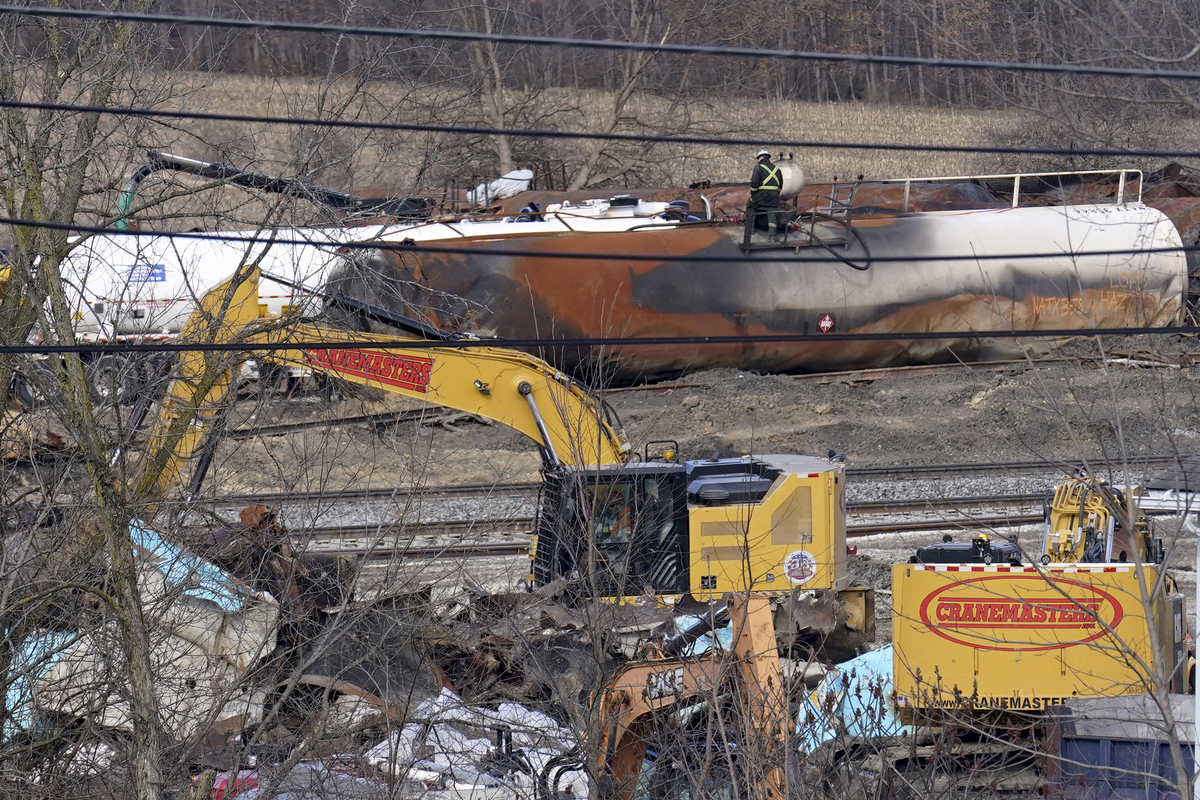Here's the most thorough explanation yet for the train derailment in East Palestine
23, Feb 2023

This week, workers continued to clean up the derailed tank cars in East Palestine following the Feb. 3 crash. Matt Freed/AP
Matt Freed/AP

This week, workers continued to clean up the derailed tank cars in East Palestine following the Feb. 3 crash.
Matt Freed/AP
The operators of a train carrying hazardous chemicals near East Palestine, Ohio, earlier this month tried to stop the train after a wheel bearing overheated to a dangerous degree, the National Transportation Safety Board said.
By the time the train's engineers were able to get out to inspect the bearing, there already were indications the train may have derailed, according to a preliminary report released by the agency Thursday.
The NTSB's report is not a conclusive declaration of the derailment's cause. The agency is still examining the axle and wheel bearing, it said, along with parts of the tank cars that carried toxic chemicals.
But the report does offer the most detailed explanation yet of what may have sent the train off the tracks.
Norfolk Southern train 32N, traveling east along the railroad's Fort Wayne Line across Ohio, approached East Palestine just before 9 p.m. on Friday, Feb. 3.
As the train approached East Palestine, a wheel bearing on its 23rd railcar rapidly overheated, its temperature soaring to more than 250 degrees Fahrenheit above the ambient temperature.
The overheating triggered an alarm, which caused the train's engineer to immediately apply the brakes to bring the train to the stop. An automatic emergency braking system also came into effect.
But when operators exited the train to inspect the bearing, they saw fire and smoke, an indicator of a possible derailment, the report said. Ultimately, 38 cars derailed, 11 of which carried toxic chemicals.
Trackside detectors saw temperatures spiking in a wheel bearing
Cited in the NTSB's report was data collected by Norfolk Southern defect detectors, devices built along railroad lines with sensors that detect and report problems with signals and axles as trains pass by.
Three such detectors were located along 30 miles of track near East Palestine, and recorded increasing temperatures in the suspect wheel bearing, investigators said.
The third and final detector, located just east of East Palestine, recorded such a high temperature — 253 degrees Fahrenheit above ambient temperature — that the train's crew was alerted to stop the train and inspect the bearing in accordance with Norfolk Southern safety guidelines, the NTSB report said.
Only the third reading was high enough to trigger an alarm, according to the report.
More than 100,000 gallons of vinyl chloride burned
Once the crew had stopped the train, operators saw fire and smoke and alerted authorities of a possible derailment. Responders arrived soon after.
The train's movements at the time of the derailment appeared to follow safety regulations, investigators said. It was traveling at 47 miles per hour, just under the maximum speed limit of 50 miles per hour. Positive train control, an automated safety system, was enabled and operational.
There were no reported fatalities or injuries caused directly by the derailment, and responders were able to mitigate the fire within two days. But rising temperatures in one tank car carrying vinyl chloride — a toxic chemical that grows especially volatile at high temperatures — prompted concerns of an uncontrolled explosion. To prevent that, responders evacuated residents of the immediate area and performed a "release and burn" of five tank cars' worth of the chemical, some 115,580 gallons.
Residents were able to return on Feb. 8, five days after the derailment. Since then, residents have reported widespread concern about the safety of East Palestine's air and water. The Environmental Protection Agency has ordered Norfolk Southern to conduct a cleanup of the chemicals from the area's soil and water.
NPR's David Schaper contributed reporting.
 NBC News
NASCAR suspends driver Noah Gragson for liking insensitive meme depicting face of George Floyd
10 months ago
NBC News
NASCAR suspends driver Noah Gragson for liking insensitive meme depicting face of George Floyd
10 months ago
 NBC News
Jamie Foxx apologizes after 'fake friends' Instagram post is accused of being antisemitic
10 months ago
NBC News
Jamie Foxx apologizes after 'fake friends' Instagram post is accused of being antisemitic
10 months ago









